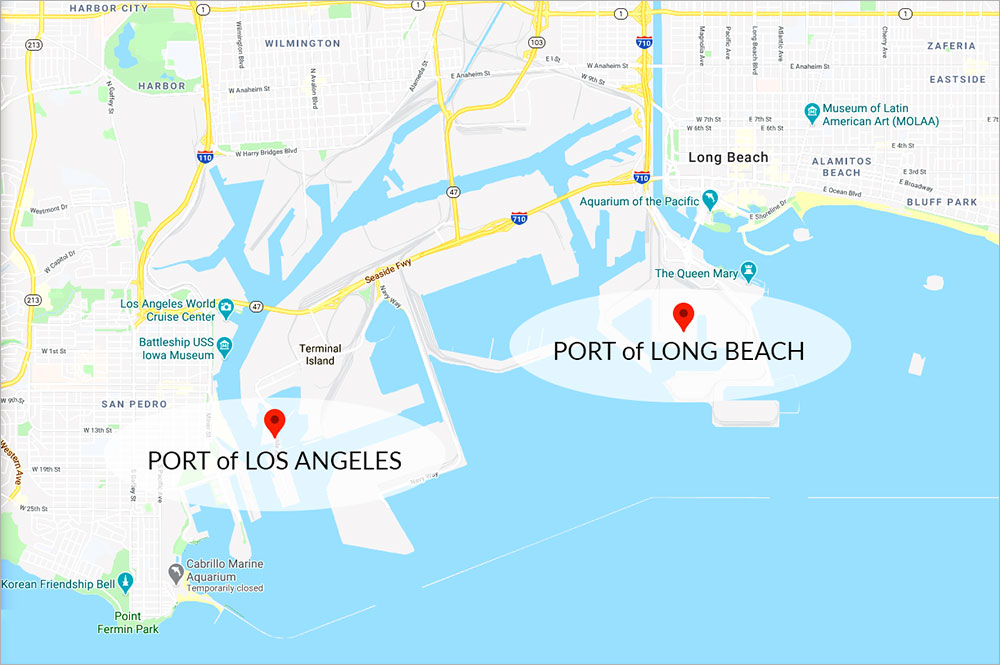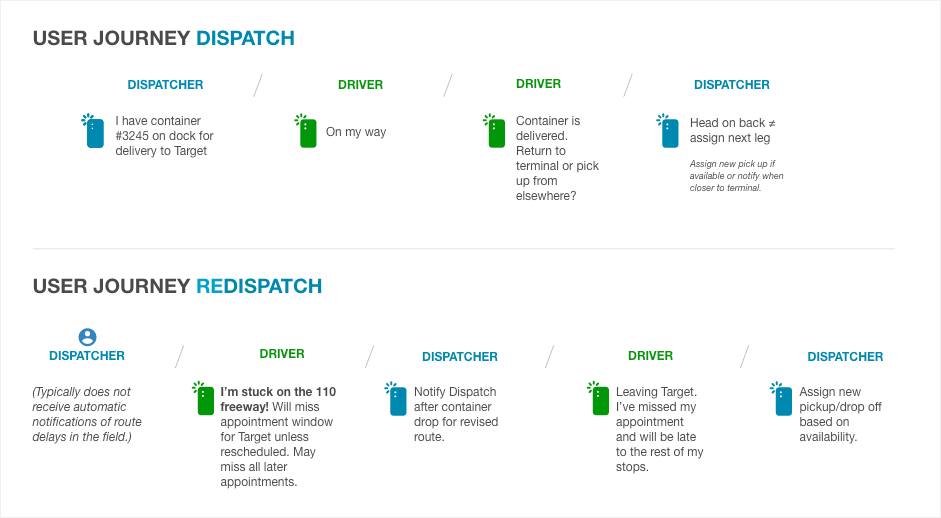Drayflex
UX Case Study #3
PROJECT TIMEFRAME: July 2019 - June 2020
CONTENTS:
- Overview
- Problem Statement
- Users and Audience
- Team Roles
- Scope and Constraints
- Process
- Outcomes and Lessons
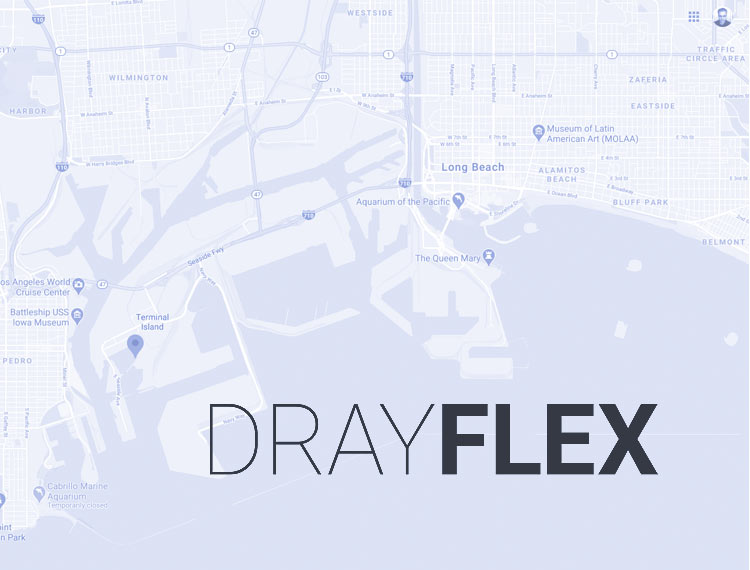
1. OVERVIEW
The Port of Los Angeles and the Port of Long Beach are the two busiest container ports in the Western Hemisphere. In the Western U.S. most products like automobiles, apparel, and electronics to name just a few, have taken the 6500 mile trip from China through one of these ports.
The port complex is a major contributor to creating freeway traffic throughout the entire Southland. InfoMagnus was contracted by the Los Angeles Metro Authority in 2018 to create a software tool that would help improve the efficiency of trucking operations in Southern California.
2. PROBLEM STATEMENT
Because of the affect port traffic has on the Los Angeles area, the Los Angeles Metropolitan Transit Authority (L.A. Metro) sought a MVP/beta solution from InfoMagnus to improve the efficiency of local drayage operations. Specifically, a desktop software tool that could bridge the gap between data-driven planning and user control to significantly improve trucking efficiency in and around the port.
Drayflex, is set to bridge that gap and solve or at least mitigate, some of the biggest problems of the broader trucking industry. Operational inefficiency not only hurts profitability but also has a wider effect in terms of Southland traffic, safety, pollution, and overall quality of life.
There were a number of data driven features that could vastly improve how trucking operations were done but my primary focus was on the experience of Dispatchers. By making the Dispatcher’s job easier and more efficient, we could also improve the conditions on the surrounding roads, particularly the 710 Long Beach freeway.
3. USERS AND AUDIENCE
Dispatchers - Primary users of the system. Dispatchers are responsible for assigning trips to Drivers, prioritizing loads, troubleshooting, and serving as the primary contact between driver and trucking company.Client Management Representatives (CMR) - Manage the relationship between trucking company, port authority, and terminal. Most importantly they are responsible for setting appointments for drop off or pickups.
Fleet Managers - Oversees operations including Dispatchers and Drivers.
4. TEAM ROLES
- UI/UX Designer
- Project Manager
- Technical Lead
- Development Team (5 person remote team)
5. SCOPE AND CONSTRAINTS
Infomagnus in partnership with L.A. Metro is currently in the process of producing a software solution to assist trucking companies in:
- Assisting Dispatchers in performing critical duties such as assigning jobs to drivers (dispatching) and redispatching.
- Improving truck utilization by creating a matching algorithm and options for customization.
The software required two essential features per client specifications:
- Real-time redispatch of any driver expected to miss an appointment window by using an optimal, system-generated alternative.
- Create an optimized plan for an entire fleet of trucks.
Constraints
There were a number of major constraints that affected the scope of the Drayflex product.
- Limited or no access to Terminal Management System (TMS) data or related data feeds.
- Limited access to Dispatchers. As the main target users of the system this was a big hurdle. We planned to include user testing at a later date when real data integration was available.
6. PROCESS
In order to solve the two main requirements, I needed to fully understand how redispatching and fleet planning worked in current practice. Capturing those workflow items was a responsibility I shared with my Project Manager. Our research strategy was simple; conduct as many interviews with trucking company managers and representatives as possible, document our findings and iterate on designs.
Below is a detail of the spreadsheet used to capture the operational differences from company to company.

The short term goal for demonstrations of the prototype was to determine where the gaps were in meeting each client’s specific business rules. Demonstrations were also a useful springboard for learning what other features were most important to each of our potential customers. Our intent was not to attempt in-depth user testing initially. It was determined those research efforts should wait until the database could return accurate live data in a staging environment. The practical value of demonstrating the early prototype was to use the two main scenarios as a springboard for broader discussion.
Refinements from Interviews
Interviews with stakeholders revealed that there were two primary options when it came to redispatching a driver. The first was a traditional method where the driver personally notified the dispatcher of their situation. The dispatcher would then decide on the driver's corrective course based on available information.
The other, more advanced option removed the dispatcher from the workflow entirely, notifying the driver by way of a system-generated text message. While no company we spoke to used this model, several of them expected some type of implementation in the coming year. A mobile app for drivers was determined to be out of scope, so we focused on improving the traditional method.
When it came time to identify the key factors affecting fleet planning and redispatching, it became clear from our Subject Matter Expert interviews that appointment windows were a key variable. While the importance of factors like shipping priority or late-fee penalties may vary depending on conditions, no plan of any length could be generated without first ensuring appointment availability.
With appointment windows better understood, I could iterate on my prototype to include a more flexible interaction model for redispatching and a simplified interface for fleet planning.
The user interface for dispatching allows dispatchers a way to
- Receive a priority notification when a driver was in danger of missing an appointment window.
- Change the at-risk driver’s plan on the fly to minimize the impact of a delayed leg.
- Have the system generate a new optimized plan which could be manually overridden by the dispatcher.
The user interface for fleet planning allows dispatchers and managers a way to
- Take into account driver and company preferences when matching load to driver.
- Manually assign unmatched drivers
- Re-run the plan at any point during the day.
Dispatching and Redispatching Deep DiveEarly whiteboard sessions helped to flesh out the most likely scenarios that could be expected when redispatching. A major consideration in redispatching is the exponential effect it had on the remaining moves available. The problem and solution is beyond the scope of this case study but below is an early attempt to wrap our collective heads around the parameters involved.
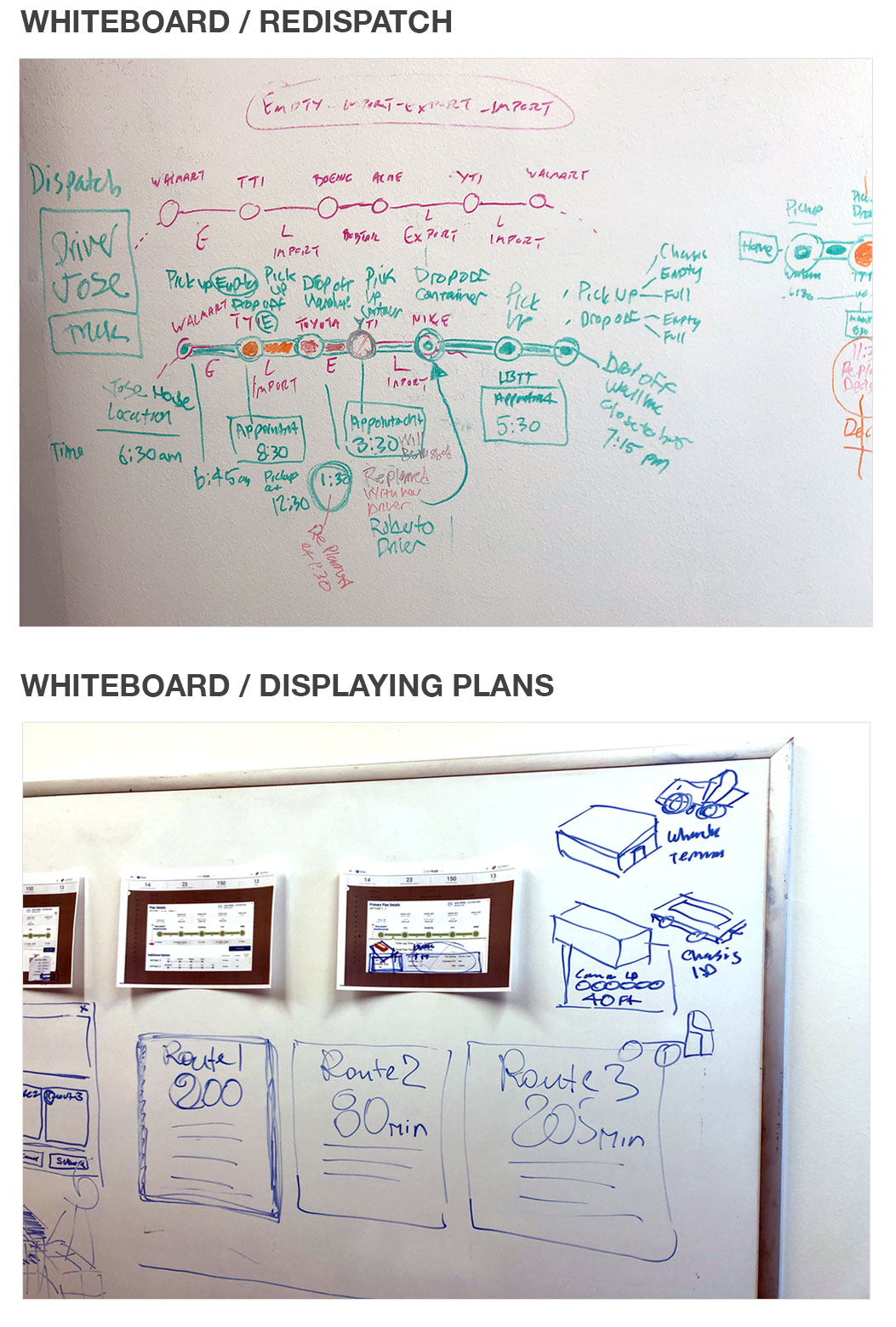
The current state of Drayflex dispatch/redispatch interface appears below. It allows for maximal flexibility, displaying a weighted ranking of available moves to Dispatchers and allowing them to select their own move or moves if preferred. In addition, there are controls for removing and adding legs, a notification system for Dispatchers, a snooze function, and a simple copy/paste system for capturing basic information.
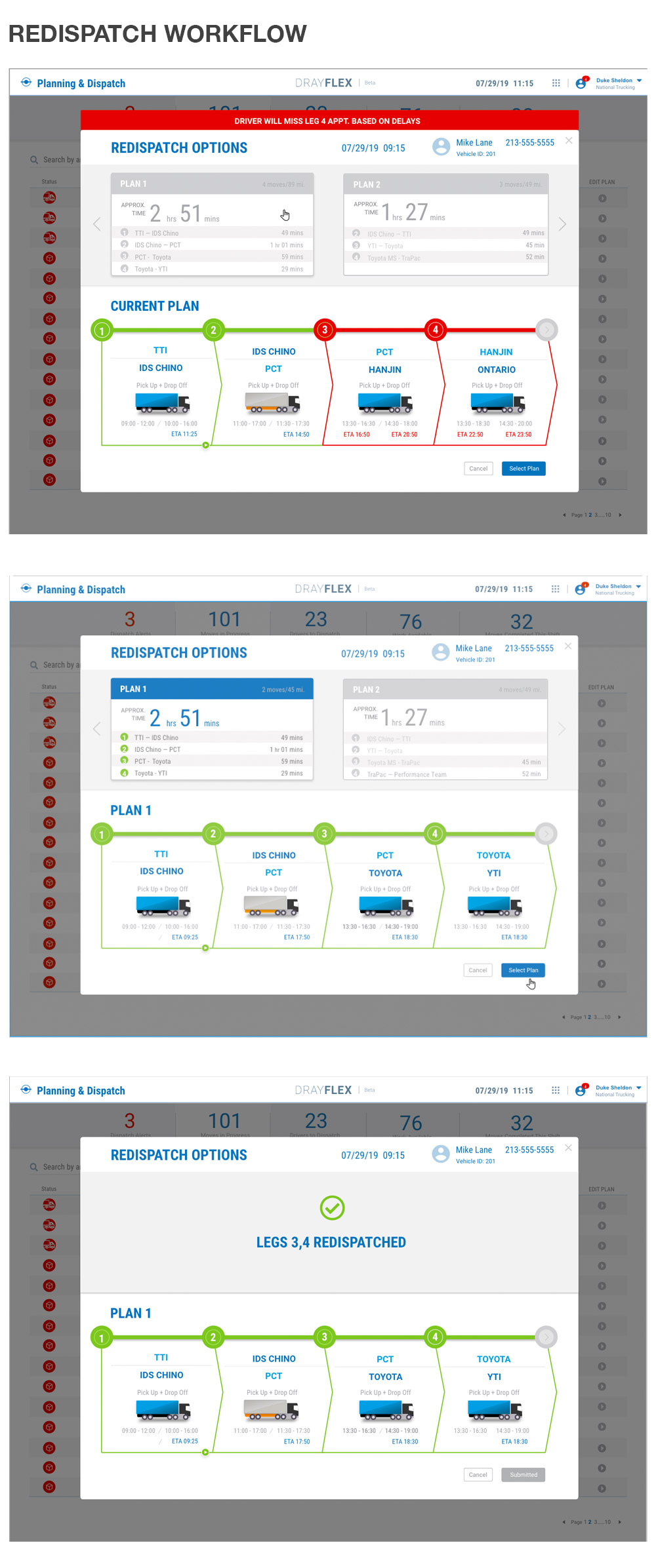
Changing FocusThe bigger concerns of the L.A. Metro project were to improve the efficiency of trucking operations and by doing so reduce the number of trucks on Southern California freeways. Redispatching and fleet planning are just two ways of achieving those end goals but they aren’t the only ways. As we conducted more interviews improving our understanding of how diverse the trucking industry was, we began to shift our focus to optimization. The functions of optimization are key to fleet planning and overlap significantly with redispatching. The new challenge was how to go about accommodating the different priorities of each company with the algorithm being developed for optimization.
Jim, a Manager at Container Port Group in Memphis, Tennessee had little use for a fleet planning tool and only slightly more interest in redispatching. Far more interesting to him as a Manager was how Drayflex could help him schedule as many “drop and hook” or dual transaction trips as possible. A “drop and hook” trip means a driver delivers a full container to a customer (let’s say a Target Store warehouse for example) and then leaves that drop-off point with a new container. It is less important that the new container is full or empty. The more dual transactions the better as it reduces the overall miles required per truck and maximizes their efficiency. Likewise, Target gets a container moved where it's needed. When a single site drop and hook could not be scheduled the Drayflex algorithm would try to match delivery and pick up by next closest proximity, minimizing the number of miles driven with no container at all.
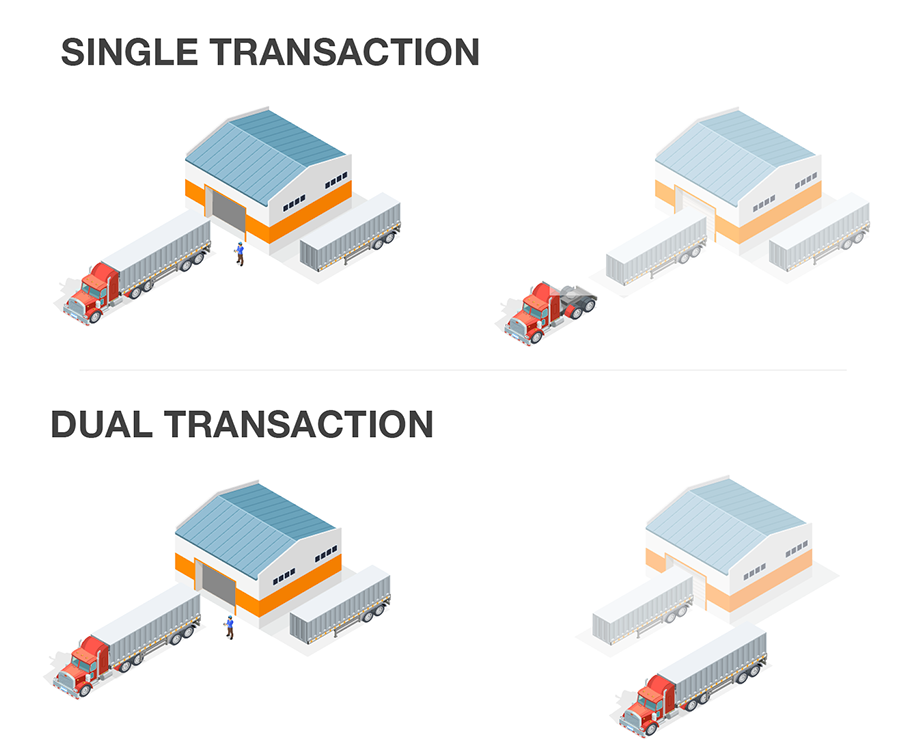
Jim was not the first to mention how valuable maximizing drop and hook trips were. Container Port Group (CPG) didn’t require large scale fleet planning or a high volume of re-dispatches. They operated conservatively, on a modest margin, and optimizing trips was of critical importance. Optimizing for drop and hooks was a single data point among many data points collected but after speaking to a number of managers the subject eventually bubbled to the top. Seen at first as a nice-to-have feature it became a critical component of the optimization feature.
These new changes helped push Drayflex into a more complete planning tool that could work independently of TMS systems. As we continued to speak with trucking line managers and owners it became apparent that The ideal planning tool for our customers needed to be flexible, intuitive, and customizable.
7. OUTCOMES AND LESSONS
Solving big, complex problems like improving the drayage industry was overwhelming at times. Just understanding the roles involved in moving a single container thousands of miles was a major undertaking. The complexity grew dependent on the number of trucks in a given fleet which as a unknown quantity became its own challenge. Engineering for an industry so complex, with so many moving parts and so many variables became an exercise in limitations. Working within those limitations was at first a daunting prospect but later as we began to untangle the interdependent components we saw many of the limitations as a gift. The scope of our product was better defined. Our features limited but not so much that we could not deliver on the primary objectives. We benefited from limited scope and at the same time acquired enough knowledge so that the later releases of Drayflex could be exponentially more effective in solving the overarching goals.
The Drayflex system is a unique solution to a problem shared by every trucking company in every major port worldwide. It does not attempt to solve all of the problems they face but it does provide a new tool to use in the battle against inefficiency. The difficulty of capturing how these independent businesses were similar and different made the challenge of finding a better system that much more interesting.
A pilot of the Drayflex product is expected to be implemented later this year. The design portion of the project has been approved and engineering has completed about 95% of the interface as of June of 2019.
A select group of 5-10 drivers will receive their daily plans and dispatch assignments using a beta of the Drayflex system. A successful implementation means InfoMagnus can begin to collect valuable data about the effectiveness of specific features as well as how they address the bigger issues. The immediate impact should be trucks spending fewer hours on the road or waiting in the Terminal. Drivers and trucking companies will improve their margins and the 710 freeway will hopefully get just a little less terrifying.
← Back
